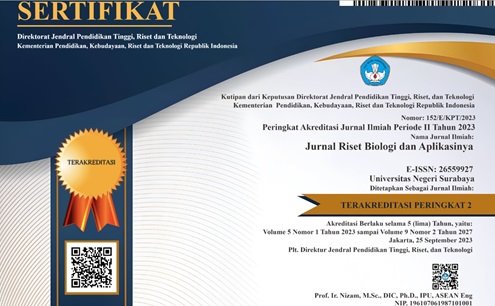DNA Barcode of Homalomena pexa inferred from Internal Transcribed Spacer Region
DOI:
https://doi.org/10.26740/jrba.v4n2.p69-74Keywords:
DNA Barcode, ITS, Phylogenetic, Homalomena pexaAbstract
Homalomena pexa, a tomentose haired-leaf aroid, was a newly discovered and described plant species in early 2020. This species has currently only been reported from South Tapanuli. A molecular study to provide DNA sequence is essential in this preliminary investigation. This research aimed to characterize the barcode sequence of H. pexa and estimate the species' position in an Araceae phylogenetic tree. This research used ITS sequence to perform DNA barcoding on H. pexa. The sequencing result revealed that 1040 bp nucleotides were effectively amplified. The phylogenetic tree generated using the Neighbor-Joining method and the Kimura 2-parameter revealed that H. pexa clustered with H. atrox and H. humilis, with a bootstrap value of 97%. This investigation provided and demonstrated that ITS sequences could be used to validate and support the proper identification of Araceae species.
References
Balkanska, R., Stefanova, K., Stoikova-Grigorova, R., & Ignatova, M. (2020). A preliminary assessment of trnH-psbA as DNA barcode for botanical identification of polyfloral honey samples and comparison with rbcL marker. Bulg J Agr Sci. 26(1), 238-242. https://journal.agrojournal.org/page/download.php?articleID=2721
Boyce, P. C., & Yeng, W. S. (2016). Studies on Homalomeneae (Araceae) of Sumatera IV: three new ornamental Homalomena (Chamaecladon clade) species. Willdenowia. 46(2), 253-260. https://doi.org/10.3372/wi.46.46206
CBOL Plant Working Group. (2009). A DNA barcode for land plants. PNAS, 106(31), 12794-12797. https://doi.org/10.1073/pnas.0905845106
Chen, J., Henny, R.J. & Liao, F. (2007). Aroids are Important Medicinal Plants. Acta Hortic. 756: 347-354. https://doi.org/10.17660/ActaHortic.2007.756.37
Clement, W. L., & Donoghue, M. J. 2012. Barcoding success as a function of phylogenetic relatedness in Viburnum, a clade of woody angiosperms. BMC Evol Biol. 12(1): 1-13
Felsenstein, J. (1985). Confidence limits on phylogenies: an approach using the bootstrap. Evol. 39(4): 783-791. https://doi.org/10.1111/j.1558-5646.1985.tb00420.x
Govindaraj, M., Vetriventhan, M., & Srinivasan, M. (2015). Importance of genetic diversity assessment in crop plants and its recent advances: an overview of its analytical perspectives. Genet Res Inter. https://doi.org/10.1155/2015/431487
Hariri, M. R., Peniwidiyanti, P., Irsyam, A. S. D., Irwanto, R. R., Martiansyah, I., Kusnadi, K., & Yuhaeni, E. (2021a). Molecular Identification and Morphological Characterization of Ficus sp. (Moraceae) in Bogor Botanic Gardens. J Biodjati. 6(1), 36-44. https://doi.org/10.15575/biodjati.v6i1.10852
Hariri, M. R., Irsyam, A. S. D., Setiawan, A. B., Setiawan, E., Irwanto, R. R., & Atria, M. (2021b). Identifikasi Molekuler dan Karakterisasi Morfologi Kamandin Saebo, Tumbuhan Obat dari Pulau Madura. BIOTIKA J Ilmiah Biol. 19(2): 41-48. https://doi.org/10.24198/biotika.v19i2.35627
Hung, J. H., & Weng, Z. (2016). Sequence alignment and homology search with BLAST and ClustalW. Cold Spring Harbor Protocols, 2016(11), pdb-prot093088. https://doi:10.1101/pdb.prot093088
Irsyam, A. S. D., Hariri, M. R., Peniwidiyanti, P., & Irwanto, R. R. (2021). Note on the genus Dorstenia Plum. ex L.(Moraceae) in Java (Indonesia) and noteworthy information on the identity of D. bahiensis through ITS sequence. Biodiversitas J Biol Divers. 22(8). https://doi.org/10.13057/biodiv/d220832
Jobst, J., King, K., & Hemleben, V. (1998). Molecular evolution of the internal transcribed spacers (ITS1 and ITS2) and phylogenetic relationships among species of the family Cucurbitaceae. Mol Phylogenet Evol. 9(2): 204-219. https://doi.org/10.1006/mpev.1997.0465
Kimura, M. (1980). A simple method for estimating evolutionary rates of base substitutions through comparative studies of nucleotide sequences. J Mol Evol. 16(2): 111-120
Kumar, S., Stecher, G., Li, M., Knyaz, C., & Tamura, K. (2018). MEGA X: molecular evolutionary genetics analysis across computing platforms. Mol Biol Evol. 35(6), 1547. https://doi.org/10.1093/molbev/msy096
Li, H. & Boyce, P. C. (2010). Homalomena. Fl Chi. 23: 17-18
Li, H. Q., Chen, J. Y., Wang, S., & Xiong, S. Z. (2012). Evaluation of six candidate DNA barcoding loci in Ficus (Moraceae) of China. Mol Ecol Res. 12(5): 783-790. https://doi.org/10.1111/j.1755-0998.2012.03147.x
Podani, J. (2010). Monophyly and paraphyly: A discourse without end?. Taxon, 59(4), 1011-1015. https://doi.org/10.1002/tax.594002
POWO. (2022). Plant of The World Online. [Online]. Available: https://powo.science.kew.org/taxon/urn:lsid:ipni.org:names:30048023-2
Saitou, N., & Nei, M. (1987). The neighbor-joining method: a new method for reconstructing phylogenetic trees. Mol Biol Evol, 4(4): 406-425. https://doi.org/10.1093/oxfordjournals.molbev.a040454
Sun, Y., Skinner, D. Z., Liang, G. H., & Hulbert, S. H. (1994). Phylogenetic analysis of Sorghum and related taxa using internal transcribed spacers of nuclear ribosomal DNA. Theor Appl Genet, 89(1), 26-32
Vasconcelos, S., de Lourdes Soares, M., Sakuragui, C. M., Croat, T. B., Oliveira, G., & Benko-Iseppon, A. M. (2018). New insights on the phylogenetic relationships among the traditional Philodendron subgenera and the other groups of the Homalomena clade (Araceae). Mol Phylogenet Evol, 127: 168-178. https://doi.org/10.1016/j.ympev.2018.05.017
White, T. J., Bruns, T., Lee, S. J. W. T., & Taylor, J. (1990). Amplification and direct sequencing of fungal ribosomal RNA genes for phylogenetics. PCR Protocols: A Guide to Methods and Applications, 18(1): 315-322
Widiyanti, D. N., & Mukarlina, M. T. (2017). Inventarisasi Tumbuhan Araceae Di Hutan Desa Subah Kecamatan Tayan Hilir Kabupaten Sanggau Kalimantan Barat. J Protobiont, 6(3), 207-214. http://dx.doi.org/10.26418/protobiont.v6i3.22478
Wong, S. Y., Boyce, P. C., & Hay, A. (2020). Studies on Homalomeneae (Araceae) of Sumatera VI: Two remarkable new species of Homalomena [Chamaecladon Clade]. Webbia, 75(1), 117-122. https://doi.org/10.36253/jopt-7947
Yeng, W. S., Jean, T. P., Kiaw, N. K., Othman, A. S., Boon, L. H., Ahmad, F. B., & Boyce, P. C. (2013). Phylogeny of Asian Homalomena (Araceae) based on the ITS region combined with morphological and chemical data. Syst Bot, 38(3), 589-599. https://doi.org/10.1600/036364413X670430
Downloads
Published
How to Cite
Issue
Section
License
Copyright (c) 2022 Jurnal Riset Biologi dan Aplikasinya

This work is licensed under a Creative Commons Attribution-NonCommercial 4.0 International License.
 Abstract views: 634
,
Abstract views: 634
, PDF Downloads: 222
PDF Downloads: 222












